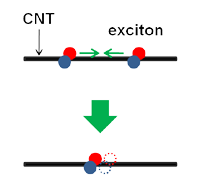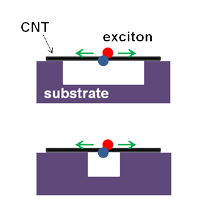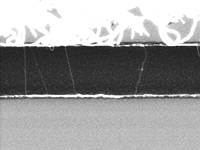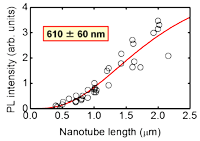Research:Exciton diffusion in carbon nanotubes
In single-walled carbon nanotubes (SWCNTs), Coulomb interaction is strong because of the one-dimentional structure. This causes electrons and holes to form tightly bound excitons, and they play a central role in optical processes in SWCNTs. In particular, a process called exciton-exciton annihilation determines the optical emission efficiency. This process happens when two excitons collide, and it results in one of the excitons to nonradiatively decay into the ground state. The rate at which these collisions occur is set by the spatial range that the excitons traverse through diffusion.


We investigate the diffusion length of excitons by measuring photoluminescence (PL) from nanotubes suspended over trenches of various widths. Because the substrate induces a very rapid nonradiative decay of excitons, it serves as a sink for excitons. For narrower trenches, more excitons diffuse out of the suspended part and nonradiatively recombine, so we expect PL efficiency to decrease. Degree of the reduction of PL efficiency is largely determined by the diffusion length. Therefore it should be possible to obtain the diffusion length of excitons by analyzing the nanotube length dependence of the PL intensity.
In order to obtain suspended SWCNTs, trenches with various widths are formed on Si substrates using standard lithography and dry etching processes. Catalyst is placed next to the trenches, and alcohol catalytic chemical vapor deposition is used to grow SWCNTs. A scanning electron microscope image of a typical sample is shown. These suspended as-grown SWCNTs are very clean, and exhibit excellent optical and electrical properties.


Individual nanotubes are identified by PL imaging, while their chiral indices are determined by excitation spectroscopy. We look for individual SWCNTs that are fully suspended and bright. We also perform polarization measurements to find the nanotube angle with respect to the trench. This allows accurate determination of the suspended length. The figure shows a result of nanotube-length dependent PL measurement. PL intensity is plotted against the nanotube length. We simulate the nanotube-length dependence using steady-state diffusion equations and least-square fit to the data is shown as a red line. This procedure yields a diffusion length of 610 nm, which is much longer than previously obtained values for micelle-wrapped SWCNTs. This implies that exciton-exciton annihilation is much more efficient for suspended nanotubes, and this is favorable for single photon sources which require removal of excess excitons.
To learn more about this work, please refer to:
Exciton diffusion in air-suspended single-walled carbon nanotubes
Phys. Rev. Lett.
104, 247402 (2010).
![]()